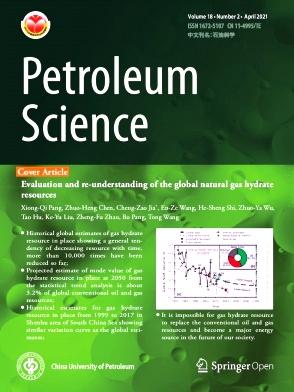利用 TTI 介质系统预测裂缝页岩储层的含气量、裂缝和脆性
IF 6
1区 工程技术
Q2 ENERGY & FUELS
引用次数: 0
摘要
主要目的是通过预测页岩储层的地震甜点参数,优化页岩气富集区的开发。我们系统地评估了裂缝含气页岩储层的裂缝发育、裂缝气体含量和岩石脆性。为了更好地描述具有倾斜裂缝的含气页岩储层,我们基于等效介质理论优化了岩石物理模型。基于页岩岩石物理模型的优势,在优化脆性指数时,我们不仅考虑了脆性矿物组分,还考虑了页岩孔隙度、气体饱和度和总有机碳(TOC)的综合影响。由于裂缝通常是流体存储和移动的重要通道,因此裂缝密度和裂缝流体识别系数是裂缝储层预测的关键地球物理参数。我们定义了一种新的裂缝气体指示因子(GFI)来检测裂缝有效气体含量。重新推导了倾斜横向各向同性(TTI)介质的新线性 PP 波反射系数方程,实现了从偏移矢量瓦(OVT)域地震数据直接预测各向异性裂缝参数和各向同性弹性参数。合成地震数据实验证明,基于 LP 类矩稀疏性约束和分量反演策略的反演算法具有很高的稳定性和抗噪能力。最后,我们将新的预测方法用于评估中国四川盆地的裂缝含气页岩储层,证明了其有效性。本文章由计算机程序翻译,如有差异,请以英文原文为准。
Systematic prediction of the gas content, fractures, and brittleness in fractured shale reservoirs with TTI medium
The main objective is to optimize the development of shale gas-rich areas by predicting seismic sweet spot parameters in shale reservoirs. We systematically assessed the fracture development, fracture gas content, and rock brittleness in fractured gas-bearing shale reservoirs. To better characterize gas-bearing shale reservoirs with tilted fractures, we optimized the petrophysical modeling based on the equivalent medium theory. Based on the advantages of shale petrophysical modeling, we not only considered the brittle mineral fraction but also the combined effect of shale porosity, gas saturation, and total organic carbon (TOC) when optimizing the brittleness index. Due to fractures generally functioning as essential channels for fluid storage and movement, fracture density and fracture fluid identification factors are critical geophysical parameters for fractured reservoir prediction. We defined a new fracture gas indication factor (GFI) to detect fracture-effective gas content. A new linear PP-wave reflection coefficient equation for a tilted transversely isotropic (TTI) medium was rederived, realizing the direct prediction of anisotropic fracture parameters and the isotropic elasticity parameters from offset vector tile (OVT)-domain seismic data. Synthetic seismic data experiments demonstrated that the inversion algorithm based on the LP quasinorm sparsity constraint and the split-component inversion strategy exhibits high stability and noise resistance. Finally, we applied our new prediction method to evaluate fractured gas-bearing shale reservoirs in the Sichuan Basin of China, demonstrating its effectiveness.
求助全文
通过发布文献求助,成功后即可免费获取论文全文。
去求助
来源期刊

Petroleum Science
地学-地球化学与地球物理
CiteScore
7.70
自引率
16.10%
发文量
311
审稿时长
63 days
期刊介绍:
Petroleum Science is the only English journal in China on petroleum science and technology that is intended for professionals engaged in petroleum science research and technical applications all over the world, as well as the managerial personnel of oil companies. It covers petroleum geology, petroleum geophysics, petroleum engineering, petrochemistry & chemical engineering, petroleum mechanics, and economic management. It aims to introduce the latest results in oil industry research in China, promote cooperation in petroleum science research between China and the rest of the world, and build a bridge for scientific communication between China and the world.
 求助内容:
求助内容: 应助结果提醒方式:
应助结果提醒方式:


